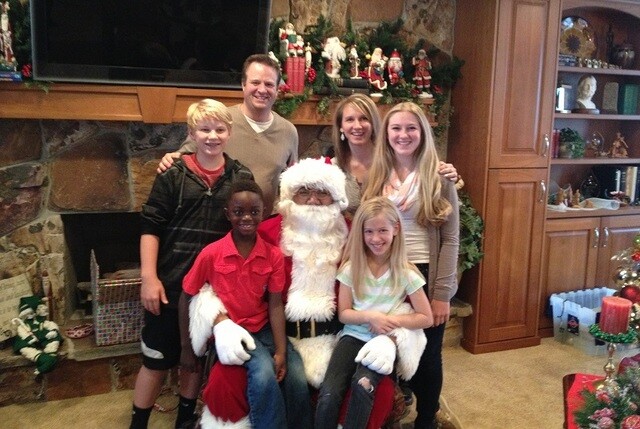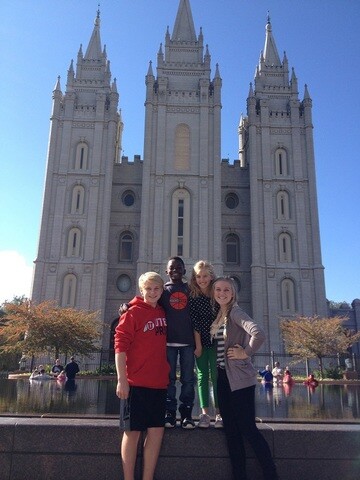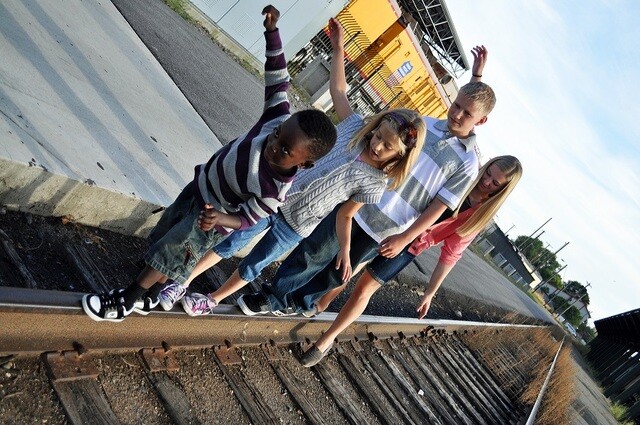In bringing home our son, Elie (A’lee) from the Democratic Republic of Congo (DRC) five years ago, my previously only-Caucasian family added layers of complexity and richness to our lives. The benefits and challenges continue to emerge.
Maybe you’ve seen the demonstration about skin color where several different shades of eggs are cracked open to reveal they’re all the same inside. This object lesson makes the rounds in discussions on race and has its merits, yet living day-to-day as a transracial family involves much more than that.
In bringing home our son, Elie (A’lee) from the Democratic Republic of Congo (DRC) five years ago, my previously only-Caucasian family added layers of complexity and richness to our lives. The benefits and challenges continue to emerge.
A Second Hometown
In adopting our son from an orphanage in Kinshasa, we adopted his birthplace too. In fact, Elie’s country has become part of our family’s identity. From the hand-carved okapi on our bookshelf to the bold-patterned skirts and ties made from Congolese fabric, our home expresses our son’s origin.
We crave all things Congo, seeking out food, events, and people to connect us with the resource-rich and conflicted country we’ve grown to love. We’ve attended African festivals, met with Congolese refugees, and invested time reading and watching documentaries. Like appetizers, these activities give us a taste, but never fully satisfy.
One of the more unexpected elements of transracial adoption comes from other people’s expectations. Though admittedly under-qualified, we regularly dispense information about DRC. People ask questions, and we hold ourselves accountable to share with them what we know about a place that is much more than its river and civil wars, yet much less than the entire African continent.
We see our fellow DRC adoption families at yearly reunions and support each other online across state lines. I correspond with friends I met at church in Kinshasa, as well as with Elie’s orphanage director. We keep in touch with the LDS missionary couple who shared their flat in Kinshasa with Elie and me and another adopting mom and child. I engage in lengthy phone conversations with this other mom, my travel companion and forever friend. We video-chat and vacation with Elie’s biological brother (whom we discovered after our adoption), who lives with his new family in another state.
We worry for Congo. We pray for it. We rejoice in its progress and believe in the strength and resiliency of its people. And all of us long to either return or visit for the first time.
Expanding Culture
Our son spent the first five years of his life half a world away, then lost his birth family and country. We want to help him hold on to at least some of his culture. When he balances a basket of toys or a potluck dish on his head, he lights up. “Remember this from Congo, Mom?” I encourage him. When his body moves miraculously, whether on the football field or dancing in our kitchen, I tell him that the Congolese are known for their creative moves. And when choosing colors, he prefers pink or purple, so I remind him that Congolese men traditionally wear brighter colors, while women wear subdued shades.
In ways we couldn’t have replicated, adopting our son heightened our family’s awareness of the world beyond our immediate community. We experience regular reminders of the significance of culture. Daily life has changed because of our son’s heritage. A completely different knowledge of hair and skin care products became necessary. Our rice cooker steams at least three times a week now with Elie’s comfort food and our adopted staple. We talk about a country we barely considered before almost every day now. All of this is expanding us.
It’s common for parents of one child to wonder how they could ever love another as much, yet when that second child arrives, they grow this separate and equal love for them. It works that way with cultures, too. Missionaries experience this. My family realizes this, making us much more open to not only accepting others for their differences but also eagerly wanting to reach out and learn more.
For instance, in her class at school, our daughter mentors a boy who is new to our country as an African refugee. She comes home with stories emphasizing her opportunity to learn about his culture.
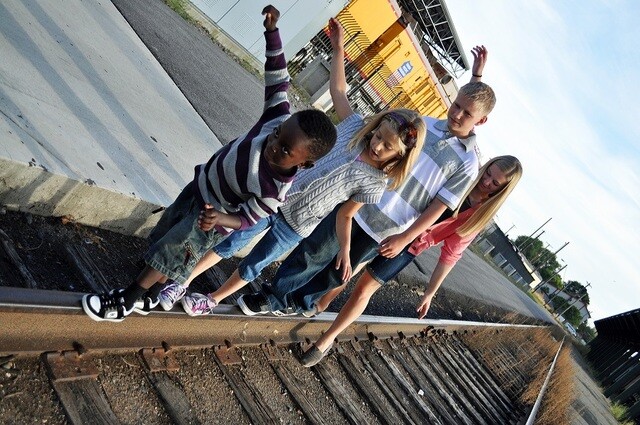
Culture Within a Culture
Elie also fits into a unique though growing population at church, and so I am becoming a student of the black Mormon experience. I follow the Black Latter-day Saints and Utah Transracial Adoption groups on Facebook and attend related conferences and lectures. As I gain more awareness, I’m realizing that no matter how much I learn, I will never really understand.
Where we live in northern Utah, it’s common for our son to be the only black attendee in our ward. When he’s not, he’s the first to point it out. It matters to him. We want Elie to know he’s not alone as a black Church member, so we found Genesis—a group for black Mormons. The Utah Genesis Group meets the first Sunday of every month and is administrated by the Church—led by a presidency called by the General Authorities.
The first time we attended, the large room was already filled with song (the music got going early), praise, and bodies in motion. Someone pointed us to the few remaining seats in the overflow. We stayed standing, observing most of the audience clapping and swaying along with the choir—in an LDS chapel! Decked in purple choir robes, singers belted out, “Jesus! He will fix it,” over and over again. With each note as a balm for my wounds, I not only relaxed but also gradually healed from maladies I forgot I ever had. I felt even better when President Harwell (the Genesis Group's current president) leaned into the microphone after the choir finished, “Don’t worry, folks. This is The Church of Jesus Christ of Latter-day Saints.”
Raised LDS in Utah, my husband and I both typically experienced a purist brand of quiet in Church, where even one squawk removed both parent and baby from the room. When we shout at Genesis, we fit right in! We’ve learned to call and respond (“Can I get an amen!?”), sing out, and clap at church. There’s a kind of relief in this demonstrative style of worship. And joy. Joy in the present. Joy in the gospel. Joy in Jesus. And certainly joy in this new-to-us culture.
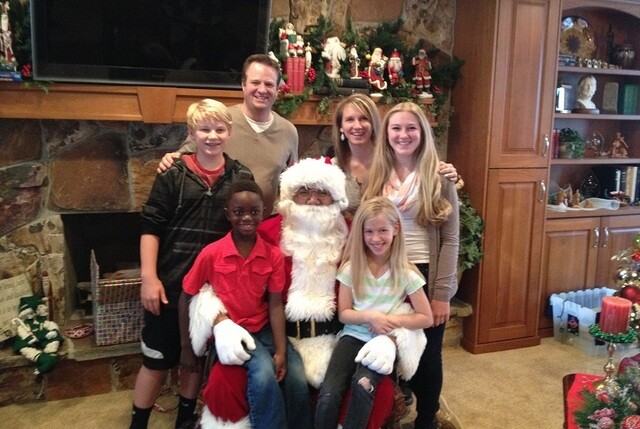
We Can’t Explain or Escape Racism
Belonging to a global Church centered on the tenet that God loves all his children, we reject racial bias. The Church’s official essay on Race and the Priesthood begins to address it, and those of us within the LDS black community eagerly await more.
Especially recently, Church materials depict our strikingly diverse membership with all its cultures and skin tones. Representation matters. As artwork within the LDS community accurately reflects its members, we all benefit. When I attend my home temple, I anticipate reaching the dressing room, where I’m moved—every time—by a large painting of a black woman kneeling. Dressed in white, with her head bowed in prayer to the God who created us both. She is my sister.
Not all of what we’ve discovered as a transracial family is positive and comfortable. We’ve been faced with racism on a very personal level. Elie daily endures hair petting and comments about his skin, which come mostly from curious people, but add up to microaggression. He has been called “the n-word” several times in the past two years. And I recognize it’s just the beginning. Friends have denied white privilege to my face and on Facebook, yet I constantly straddle my own whiteness and my son’s black reality. My sense of responsibility to speak up for him exceeds my need to speak up for my white children, and I will continue to advocate for his fair treatment and safety.
I keep writing and speaking because it’s working. Some family members and friends admit they consider race issues more deeply and differently than before by listening to us and coming to know our family. The full scope of racism extends far beyond my ability to understand it, let alone explain it, yet if my family’s experience can serve as a bridge to more awareness, I will continue to coax people across.
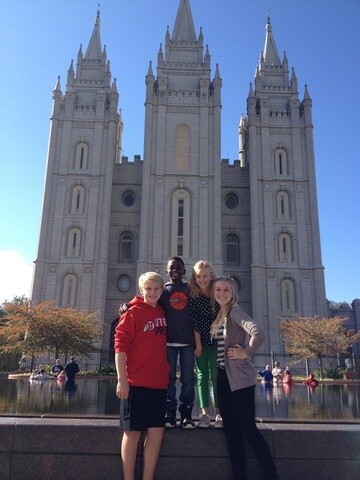
Stronger Unity
The moment my husband and I decided to adopt, our solidarity pulsed with new energy. It surged the night we told our other three children. With squeals and crying, we experienced what will go down as the most memorable FHE in our family’s history. Our purpose instantly clear, we became the conduit to God’s plan for one of his children. And ultimately, for us.
We were lucky. We know that family decisions don’t always happen with everyone’s buy-in, yet this time, all five of us felt assurance that adopting our sixth family member was right. With Elie’s referral photo in my email inbox, we huddled around the screen together as if peering through a nursery window at our newborn. His wide eyes and scared expression drew us in, and even having never seen him before, we nearly recognized him.
The international adoption process took patience, faith, and work from each of us (and our extended family), and Elie contributed more than his share by enduring without a family for more than a year until I could get to him. The waiting provided prerequisites to our advanced courses in adjusting and attaching.
Different ethnicities complicate efforts. For a few months and before he spoke English, when Elie viewed pictures of other brown-skinned people, he would either cry or kiss the screen or page. Once he found the words, he asked, “Where are the people who look like me?”
When your family does not look alike, it forces you to rethink identity and to search for unity. Since it doesn’t happen naturally, like, “She has Aunt Jenny’s freckles,” we dig harder for it. We sacrifice sameness, and I think we’re stronger for it. We purposely search for other similarities. Elie finds comfort in discovering that he’s stubborn like me, a football fan like his Dad, music-lover like one of his sisters, dancer like another, and strong like his brother.
We grow together in the gospel, where our collective testimony echoes with “I Am a Child of God” and “the worth of souls is great in the sight of God” (D&C 18:10). We joy in that “God is no respecter of persons” (Acts 10:34), and that “Jesus loves the little children . . . all the children of the world.” And we cling to promises that, “Where love is, there God is also,” and “Charity never faileth” (Moroni 7:46, 1 Corinthians 13:8).
My family challenges the notion of “color-blindness.” We celebrate Elie’s ethnicity and take pride in our differences. It’s not easy for him, and yet, we have each other. Like the furniture in our living room, our cultures and skin colors blend into a mismatched and complementary set of opportunities that personalize our family. Our transracial experience makes up just a part of our life, yet one that helps defines us.
I recognize that my perceptions are not necessarily Elie’s. Like other adoptees who grow up in families of a different race, someday he may need to dissect more of his story. I will help him, even if it hurts.
During his second year home, Elie returned from school one day, and I could tell something was wrong. I pressed, and he answered, “At lunch today, two boys said I’m black!”
I knew I didn’t have the whole story, “What did you do?”
“I said, ‘No, I’m not! I’m brown,’ then I ran away.”
We knew the other boys, who are older than Elie, good kids, and black, too. They wanted to tell our son that he was like them, and without his knowing the common term for his race, he felt defensive. We would never have guessed.
Through this and other experiences, our family continues to learn the greatest lesson—to make fewer assumptions about each other and people in general. In the most recent general conference, Sister Jean B. Bingham reminded us that, “The greatest form of charity may be to withhold judgment.”
In wanting that kind of love, we are all the same.
Images courtesy of Sherilyn Olsen.
Sherilyn Olsen is the author of the inspiring book Searched the World Over for Elie: An International Adoption Story, available at Deseret Book and deseretbook.com.
